Updated : Sep 23, 2025
From sudden regulatory changes and unpredictable weather events to shifts in guest demand and mounting owner expectations, today’s hosts in cities like Valencia are facing challenges that extend far beyond the usual seasonal fluctuations. The reality is clear: success in this new environment demands more than just competitive prices or a beautifully staged apartment—it requires a resilient, adaptive business strategy.
Drawing on PriceLabs’ deep insights and Airbnb Valencia’s own market data, this report examines what it takes to build and sustain a short-term rental business in the Spanish short-term rental market that thrives, even in the face of the unexpected.
Checklist: How Hosts Can Weather Market Shifts.
Building a resilient short-term rental business isn’t about avoiding every crisis—it’s about being ready to respond, adapt, and even find opportunities when the unexpected happens. Use this checklist as a starting point for your own “resilience audit”.
Download It NowThe New Reality for Airbnb Valencia: Disruptions Are Inevitable
For many hosts, the short-term rental market once felt predictable—demand followed the seasons, pricing rules stayed steady, and the occasional slow month was simply part of the business. That reality has shifted.
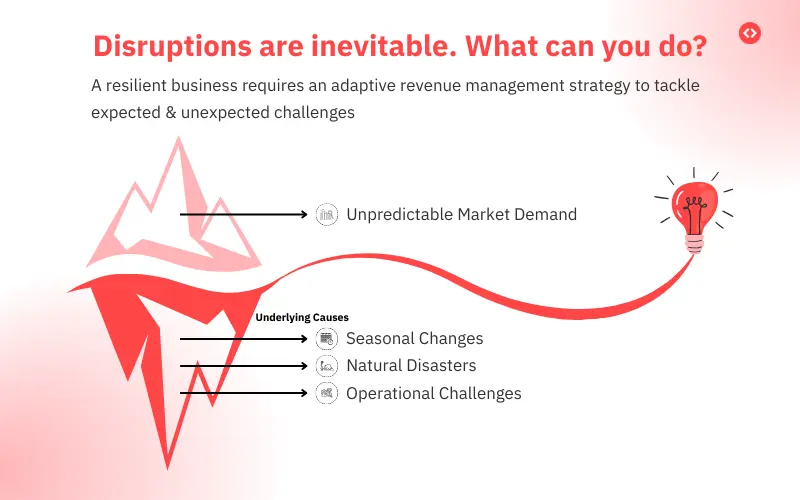
Today’s hosts operate in an environment shaped by both global forces and local surprises. From international travel restrictions and evolving guest behaviors to regional regulations and extreme weather conditions, volatility is now a part of daily operations.
Airbnb Valencia paints a clear picture of this new reality.
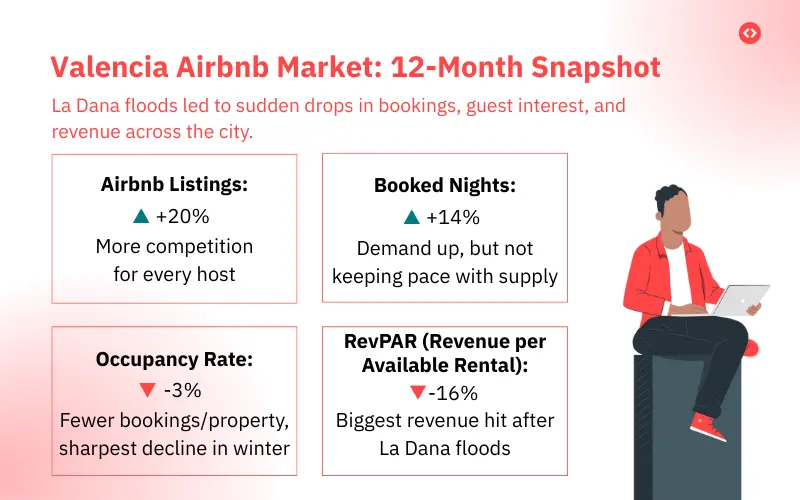
Over the past 12 months, Airbnb Valencia has experienced a 20% growth in listings, intensifying competition and making it harder for individual hosts to stand out.
Despite this growth, booked nights increased by only 14% year-over-year, and occupancy rates actually declined by 3%, with even sharper drops during the winter months, such as an 11% decline from November to January.
The La Dana floods are a stark reminder that disruption isn’t theoretical. Following the event, Valencia’s market saw a noticeable dip in bookings, guest interest, and RevPAR, with revenue per available rental dropping by as much as 16% in the immediate aftermath.
But floods are just one example—similar shocks can stem from major local events, sudden supply surges, or shifting guest preferences.
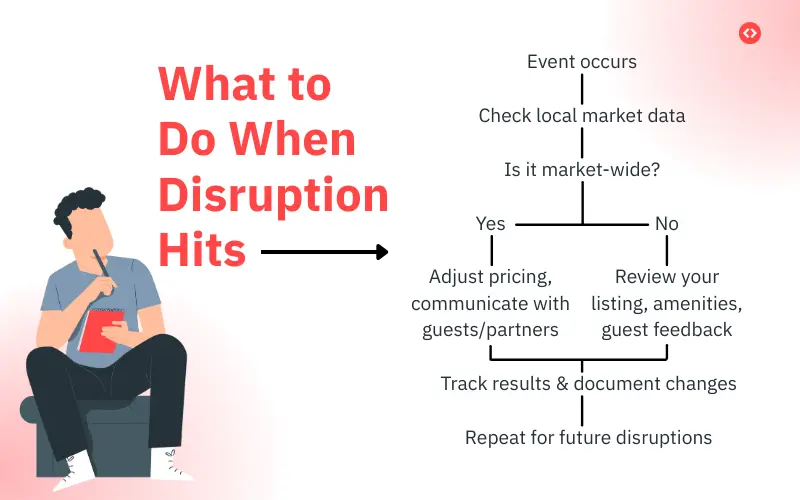
The lesson? While no one can predict every crisis, hosts who treat volatility as the norm and anchor their strategies in real-time data are far better positioned to weather these storms—and even uncover new opportunities when others pull back.
Airbnb Valencia’s Market Trends (2023–2025)
Building resilience starts with understanding the true shape of your market. PriceLabs’ data from Airbnb Valencia over the past two years reveals a market in flux—growing, but increasingly volatile, and shaped by both short-term shocks and longer-term trends.
- More Listings, Fiercer Competition: A 20% increase in active listings means more options for guests and more pressure on hosts to compete on value, not just price.
- Demand Can’t Always Keep Up: Booked nights grew by 14%, but this lagged behind the pace of new supply. This mismatch led to a 3% dip in overall occupancy—a sign that not all guests necessarily match more listings.
- Short Stays Are Still King: The 3–4 minimum-night stay segment accounted for the most booked nights, highlighting the ongoing importance of flexible minimum-stay settings and agile pricing for gap nights.
- Revenue Volatility is the New Normal: While ADR increased by 7% year-over-year, it was offset by periods of sharp decline (notably -4% in Dec–Jan). RevPAR dipped by 4% overall, and by as much as 16% during crisis periods such as the aftermath of the La Dana floods.
These trends underline why hosts must move beyond intuition, using granular, hyper-local data to inform every decision, from pricing and minimum stays to marketing and owner reporting.
Strategies for Building Resilience With PriceLabs Principles
With the Airbnb Valencia data as a backdrop, the next step is clear: hosts need strategies that work in practice—not just in theory. Building a resilient STR business means preparing for volatility, acting quickly on real data, and making adjustments before small problems become costly setbacks.
Here are four pillars for resilience, grounded in PriceLabs’ proven principles and real-world use cases.
1. Set Clear Expectations—With Yourself and Your Partners
Market shifts and slowdowns can trigger anxiety, second-guessing, and even rash decisions. Instead, resilient Airbnb Valencia hosts approach each season with eyes wide open—grounding expectations in real numbers, not just gut feel.
How to Do It:
- Track Your Core Metrics: Focus on Occupancy (percent of booked nights), ADR (average daily rate), and RevPAR (revenue per available night). For example, Valencia hosts saw a 3% occupancy dip and 7% ADR increase last year—understanding these trends helps you avoid knee-jerk reactions.
- Benchmark Regularly: Compare your results to previous years and similar properties in your market. Use tools (like PriceLabs) to spot whether you’re underperforming due to a market-wide shift, or if it’s just your listing.
- Plan for Highs and Lows: Slow seasons and sudden dips (like the La Dana floods’ 16% RevPAR drop) are inevitable. Instead of panicking, map out what “success” looks like in both good and bad periods—set minimum revenue targets that are realistic, not wishful.
- Review and Adjust: Revisit your expectations quarterly or after significant market events. Use reports and local data to guide changes—don’t rely on guesswork.
Pro Tip: Share your plans and data with cleaning partners, co-hosts, or investors (if any). Clear expectations mean fewer surprises—and smoother operations—when the market shifts.
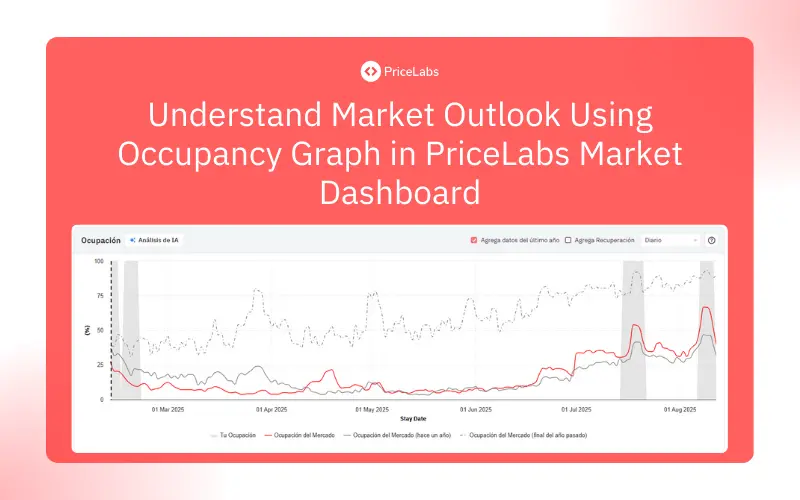
2. Adapt Your Pricing—Quickly and Often
In unpredictable markets, “set and forget” pricing is risky. A sudden drop in demand, new regulations, or a surge in new listings (like Airbnb Valencia’s recent 20% supply increase) can render your old rates obsolete overnight. Resilient hosts thrive by making data-driven price changes—fast.
How to Do It:
- Use Dynamic Pricing Tools: Leverage technology (like PriceLabs) that updates your rates daily based on real-time market trends, competitor pricing, and demand signals. This helps you capture bookings during demand spikes and minimize losses in downturns.
- React to Market Shifts: After a major event (like the La Dana floods), review your calendar. Drop prices on dates with low demand, but be strategic—target short gaps or last-minute stays rather than slashing rates across the board.
- Leverage Non-Repeating Seasons: Use advanced pricing features to create custom price periods for unique events—so you don’t undercharge during high demand or overprice when demand collapses.
- Don’t Ignore Small Adjustments: Tweaking prices for specific weekdays, weekends, or minimum stays can help fill gaps and boost your occupancy, especially when guest preferences shift.
Pro Tip: Check your dashboard regularly for price suggestions and booking patterns; automated tools are powerful, but your local insights matter, too.
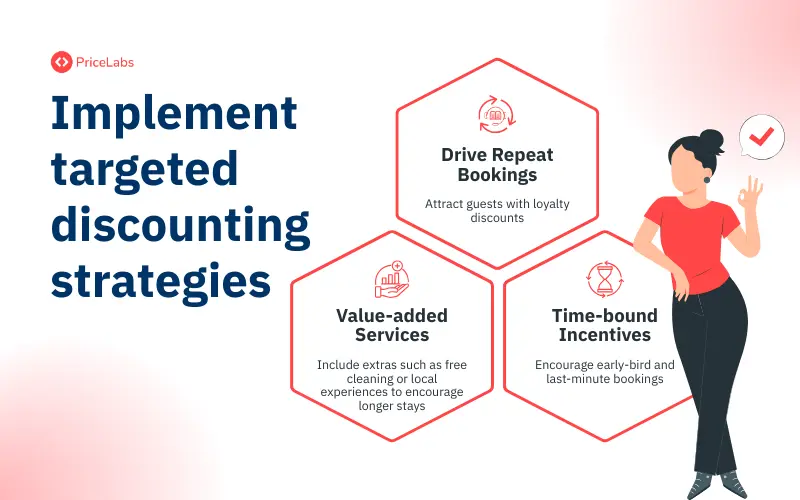
3. Diversify & Optimize Beyond Revenue Management
Pricing is only part of resilience. When bookings slow down—whether due to market shocks, off-season lulls, or increased competition—it’s what you do beyond just dropping rates that sets you apart. Smart hosts use these periods to future-proof their business and enhance guest appeal.
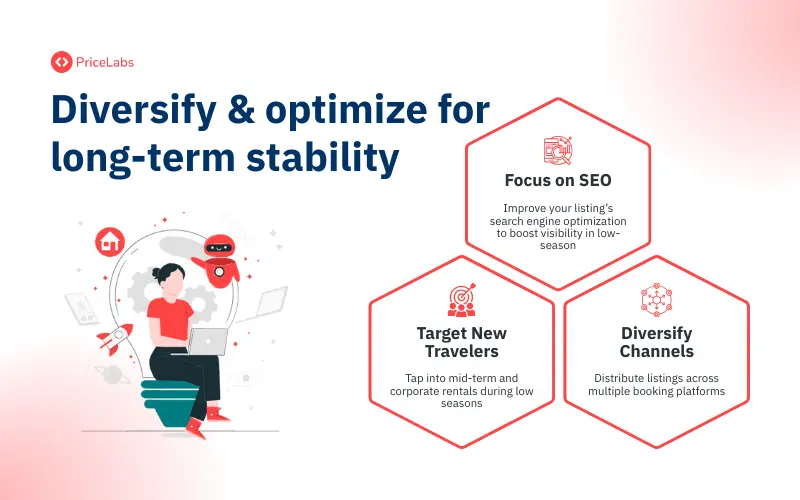
How to Do It:
- Invest in Property Upgrades: Use quieter months to tackle maintenance, update photos, add guest amenities, or refresh decor. These upgrades can justify higher rates and attract better reviews when demand rebounds.
- Expand Your Channels: Don’t rely on just one platform (like Airbnb). Listing on additional sites—such as Idealista.com or other local/vertical-specific channels—can open up new guest segments and reduce risk.
- Enhance Guest Experience: Consider flexible check-in/out, welcome gifts, or local partnerships (discounts at restaurants, experiences). Personal touches help your listing stand out, especially in a crowded market.
- Develop Repeat Business: Encourage returning guests with loyalty discounts, special offers, or referral bonuses. Building a base of loyal guests can buffer you against external disruptions.
Pro Tip: During down periods, work “on” your business—not just “in” it. These investments pay off when the market turns around.
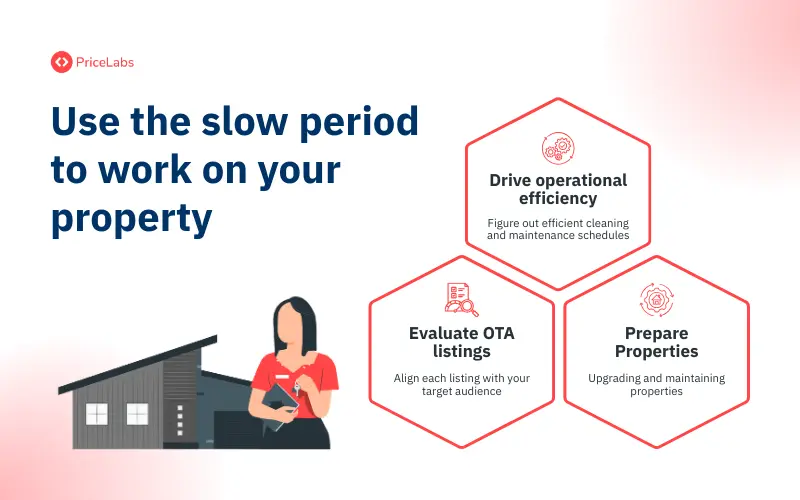
4. Proactive Communication & Reporting
Transparency and regular communication—whether with partners, co-hosts, investors, or your own future self—turns uncertainty into shared problem-solving. During disruptions or slow periods, clear reporting enables you to identify trends early, justify decisions, and maintain trust.
How to Do It:
- Regularly Review Performance Data: Don’t wait for surprises. Check your Occupancy, ADR, and RevPAR trends at least monthly. Note any sudden changes and cross-check with market data (your dynamic pricing tool or STR dashboards).
- Create Simple Reports: Even if you’re a solo host, keep a monthly or quarterly snapshot: bookings, average rates, occupancy, and notes on what changed (e.g., “ADR dropped 4% in Dec–Jan after local event cancellations”).
- Share Insights When Needed: If you co-host, partner, or have investors, share these reports—highlight both successes and challenges, and the actions you’re taking. It’s easier to keep everyone aligned when you lead with facts.
- Document What Works: Record the changes you made during market shifts (e.g., targeted discounts, channel expansion, property upgrades) and their outcomes. Over time, this creates a personalized playbook for future disruptions.
Pro Tip: Use your own data to build confidence in your decisions—when you see what’s working (and what’s not), it’s easier to adapt quickly, not react blindly.
Lessons from the La Dana Floods: What Data Really Tells Us
The La Dana floods were an extreme example of how local events can disrupt even the most established short-term rental markets. But for hosts, the real lesson isn’t about preparing for every possible disaster—it’s about learning how to interpret data during (and after) any disruption, so you can respond with clarity, not panic.
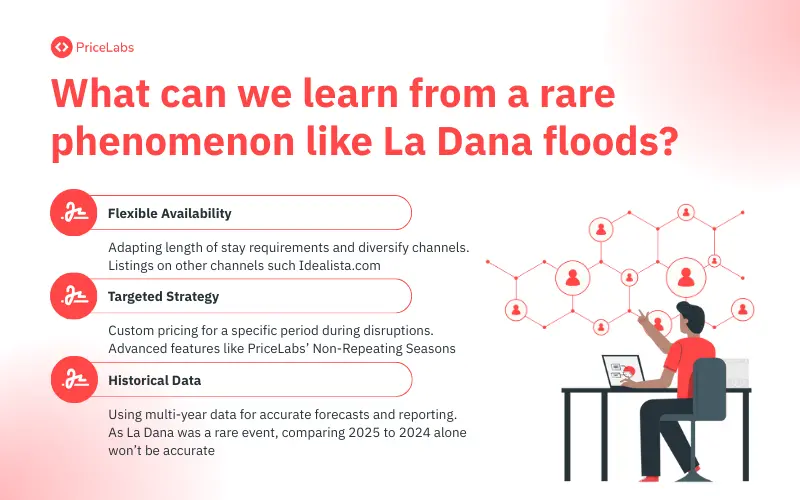
When the floods hit Airbnb Valencia, market data shifted rapidly:
- Occupancy rates saw an immediate drop, especially from November to January, with declines of up to 11% year-over-year.
- RevPAR fell by as much as 16% in the months following the floods, signaling a real hit to host revenue.
- While ADR (average daily rate) held up better, with only a 4% dip in Dec–Jan, the reality was that fewer guests were booking, even at slightly lower prices.
What can hosts take away from this?
- One-year comparisons aren’t enough. If you only look at this year versus last, rare events like floods can skew your sense of performance. Multi-year trends and local market context are essential.
- Action beats anxiety. The most resilient hosts responded by adjusting pricing quickly, offering targeted discounts, and communicating openly with partners or owners about the recovery plan.
- Unique events require flexible tools. PriceLabs’ features like non-repeating seasons let you react to exceptional market disruptions—so your pricing isn’t stuck in last year’s logic.
Disruptions will always be part of the short-term rental business. But with real-time data and the willingness to adapt, hosts can mitigate the impact—and sometimes even spot opportunities for growth when others pull back.
Conclusion: Turning Uncertainty into Opportunity
Resilience is a mindset and a practice. It means using real-time data to guide your pricing, being proactive with communication, and continually seeking ways to enhance your property and guest experience—even when the market becomes challenging. Every challenge is also an opportunity: a chance to strengthen your business, differentiate your listing, and build deeper trust with guests and partners.
The future of short-term rentals will reward hosts who treat uncertainty not as a threat, but as a call to action. With the right tools, habits, and mindset, you can not only survive market shifts—you can thrive in them.
Frequently Asked Questions: Resilience and Revenue for STR Hosts in Uncertain Markets
1. How do I know if a drop in bookings is just seasonal or something more serious?
Compare your booking pace and occupancy to both your past years and your local market (using tools like PriceLabs). Look for trends: Is the decline happening only in your listing, or across the city? Hosts experienced sharp dips after the La Dana floods, but multi-year data revealed that it was an issue affecting Airbnb Valencia as a whole, not an individual failure.
2. What’s the fastest way to adjust pricing after a local event or crisis?
Use a dynamic pricing tool that can update rates daily, and enable features like non-repeating seasons or custom discounts. After the La Dana floods, many hosts quickly dropped prices for slow weeks but kept rates steady for high-demand dates. Manual, calendar-by-calendar edits take too long—automation is your friend in a crisis.
3. Which performance metrics should I watch most closely during uncertain times?
Occupancy (how full your calendar is), ADR (average nightly rate), and RevPAR (total revenue per available night). All three together show the real health of your business. If occupancy dips but ADR rises (like in Valencia last year), check if RevPAR is holding steady or dropping.
4. How can I reassure guests and partners when disruptions hit?
Proactive communication is key. For guests: send updates, offer flexible options, and clarify policies. For co-hosts or investors: share regular reports with data and a clear action plan. Transparency builds trust—especially when the unexpected happens.
5. Should I drop my prices as soon as bookings slow down?
Not necessarily. First, check if it’s a temporary blip or a longer trend. Use data to target discounts: fill gap nights or last-minute dates, rather than blanket price cuts. Sometimes, adding value (like flexible stays or extra amenities) can attract bookings without slashing rates.












